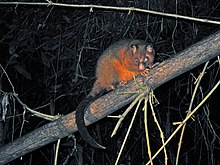Coppery brushtail possum
| Coppery brushtail possum | |
|---|---|

| |
| Scientific classification | |
| Domain: | Eukaryota |
| Kingdom: | Animalia |
| Phylum: | Chordata |
| Class: | Mammalia |
| Infraclass: | Marsupialia |
| Order: | Diprotodontia |
| Family: | Phalangeridae |
| Genus: | Trichosurus |
| Species: | T. johnstonii
|
| Binomial name | |
| Trichosurus johnstonii (Ramsay, 1888)
| |


The coppery brushtail possum (Trichosurus johnstonii) is a species of marsupial possum in the family Phalangeridae.[2] Coppery brushtails are found within the Atherton Tablelands area of Queensland, in northeastern Australia.[1][2] These mammals inhabit rainforest ecosystems, living within the tree canopy. Though they have a restricted distribution, they are locally common.[2] This population is often considered a subspecies of T. vulpecula.[1]
Description
[edit]Coppery brushtail possums have a typical length of 40–49 cm (16–19 in) and weigh 1.2–1.8 kg (2.6–4.0 lb), with males being larger and heavier than females.[3][4]
Ecology
[edit]Like the common brushtail possum, coppery brushtails are nocturnal, and live in dens, which are usually tree hollows. At night, they still spend half of their time resting to conserve energy, and the other half in foraging.[5] In feeding experiments, in selecting their food, these possums may tend to select a mix of plant materials with detoxification requirements that are correlated or independent, rather than contradictory, thus maximizing their ability to process harmful plant byproducts.[6]
Dominance among individuals tends to place females above males, and larger over smaller individuals.[7]
References
[edit]- ^ a b c Morris, K.; Woinarski, J.; Friend, T.; Foulkes, J.; Kerle, A. & Ellis, M. (2008). "Trichosurus vulpecula". IUCN Red List of Threatened Species. 2008. Retrieved 11 July 2012.
- ^ a b c Groves, C. P. (2005). "Order Diprotodontia". In Wilson, D. E.; Reeder, D. M (eds.). Mammal Species of the World: A Taxonomic and Geographic Reference (3rd ed.). Johns Hopkins University Press. p. 50. ISBN 978-0-8018-8221-0. OCLC 62265494.
- ^ Kerr, Sarah Emily (2011). Divergence of a mammal along a habitat gradient: a study of the coppery brushtail possum, Trichosurus vulpecula johnsonii (PhD Thesis). James Cook University.
- ^ Meyer, T. (2012). "Trichosurus johnstonii". Animal Diversity Web. Retrieved 29 January 2015.
- ^ Vandenbeld, John (1998). Nature of Australia: a portrait of the island continent. London: BBC Books.
- ^ Marsh, Karen J; Wallis, Ian R; McLean, Stuart; Sorenson, Jennifer S; Foley, William J (2006). "Conflicting Demands on Detoxification Pathways Influence How Common Brushtail Possums Choose Their Diets". Ecology. 87 (8): 2103–2112. doi:10.1890/0012-9658(2006)87[2103:cdodpi]2.0.co;2. JSTOR 20069195. PMID 16937649.
- ^ Blackie, Helen M; Russel, James C; Clout, Mick N (2011). "Maternal influence on philopatry and space use by juvenile brushtail possums (Trichosurus vulpecula)". Journal of Animal Ecology. 80 (2): 477–483. doi:10.1111/j.1365-2656.2010.01781.x. PMID 21155769.

